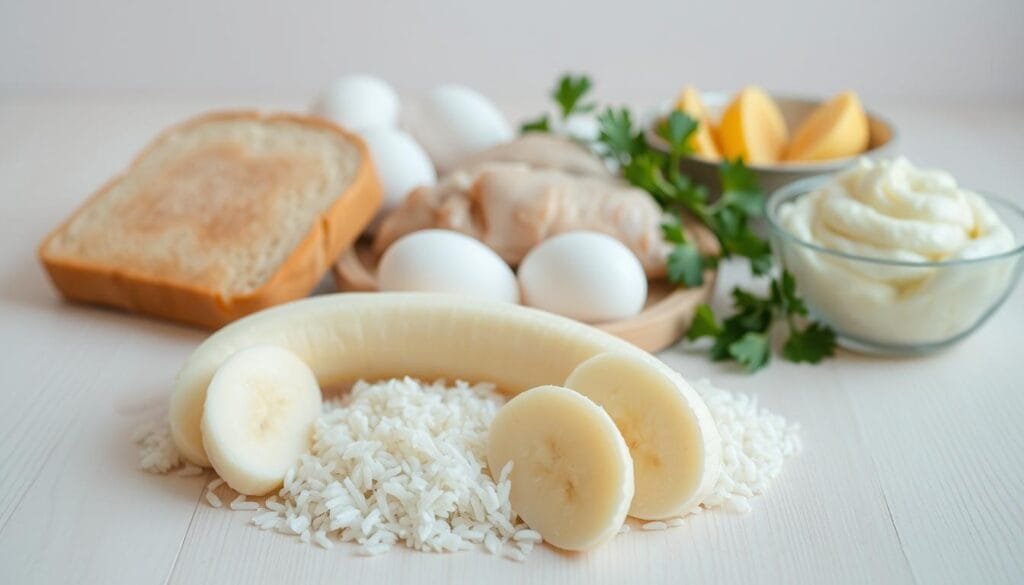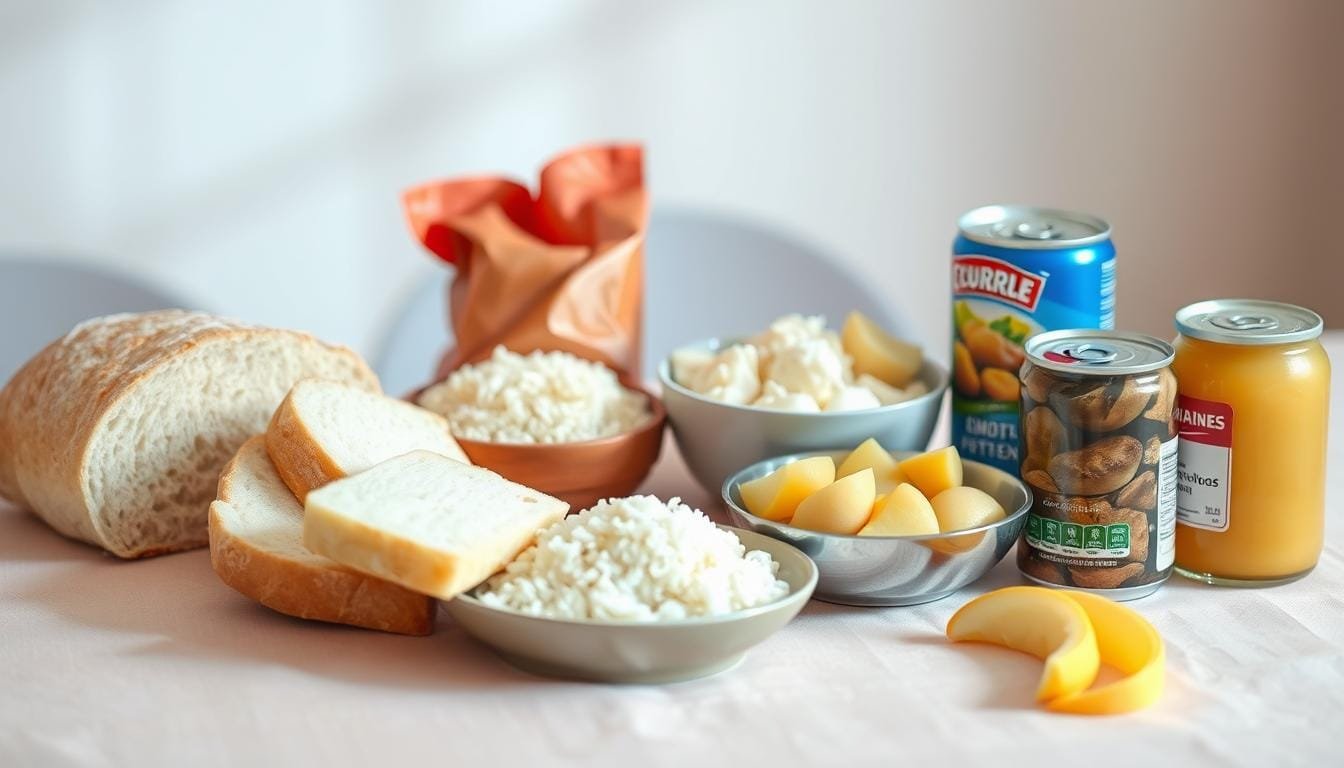Currently Empty: RM0.00
Ever wondered why some people need to cut back on fiber despite its well-known benefits? While fiber promotes digestion, certain health situations demand a temporary reduction. This adjustment helps ease discomfort during flare-ups or recovery periods.
For those with digestive disorders like Crohn’s disease or ulcerative colitis, a low-fiber diet minimizes bowel strain. It’s also common after surgeries to allow the gut to heal. Partnering with a dietitian ensures balanced meals without aggravating symptoms.
Wellness Concept offers personalized guidance, available seven days a week. Their experts help tailor meal plans for smoother digestion during sensitive phases.
Key Takeaways
- Low-fiber diets reduce bowel movement size, easing digestion.
- They are often used temporarily for IBD flare-ups or post-surgery recovery.
- Diverticulitis and Crohn’s disease are key conditions that may require this adjustment.
- Professional dietitians can create balanced low-fiber meal plans.
- Wellness Concept provides support from 9:30 AM–6:30 PM on weekdays and 10 AM–5 PM on weekends.
What Conditions Require a Low-Fiber Diet?
Managing gut health sometimes means temporarily easing up on fiber-rich foods. For those with specific digestive issues, lowering fiber intake can reduce irritation and promote healing. Here’s when experts recommend this adjustment.
Inflammatory Bowel Disease (IBD)
IBD, including Crohn’s and ulcerative colitis, often flares up with high-fiber meals. During active phases, fiber may worsen diarrhea and cramping. A modified diet helps calm inflammation.
Diverticulitis
Diverticulitis occurs when small pouches in the colon become infected. High-fiber foods can aggravate these pouches. Doctors typically advise a brief low-fiber period during recovery.
Crohn’s Disease
This chronic bowel disease causes strictures (narrowed intestines). Fiber may block these narrowed areas, leading to pain. Patients often need long-term moderation.
Ulcerative Colitis
Similar to Crohn’s, this condition inflames the colon lining. Flare-ups respond better to easily digestible foods.
“Reducing fiber during active phases can lessen bowel strain,”
notes a gastroenterologist.
Bowel Obstructions
Partial or complete blockages demand immediate fiber restriction. This prevents further pressure on the intestines. Long-term adjustments may be necessary for recurring cases.
Post-Surgical Recovery
After procedures like ileostomy, the gut needs time to heal. A temporary low-fiber plan (4–6 weeks) supports recovery. Gradual reintroduction follows once healing progresses.
How a Low-Fiber Diet Helps
Adjusting fiber intake can bring relief when the digestive system is under stress. By reducing undigested food residue, this approach eases strain on the gut, helping manage discomfort. It’s especially useful during flare-ups or recovery periods.
Reducing Digestive Strain
Soluble fiber, like oatmeal or bananas, breaks down more easily than insoluble types (e.g., nuts or celery). A low-residue diet limits bulky foods, minimizing bowel irritation. This lets the body heal without extra pressure.
For those with narrowed intestines—common in Crohn’s disease—less fiber prevents blockages. Hydration also plays a key role, softening stools and reducing cramping.
Easing Symptoms Like Diarrhea and Cramps
Fewer high-fiber foods often mean fewer diarrhea episodes. Inflammation in IBD patients may decrease, too. “Temporarily lowering fiber intake can calm an overactive gut,” explains a nutritionist.
Lean proteins and cooked vegetables are gentler alternatives. Over time, fiber can be reintroduced as tolerance improves.
Foods to Eat on a Low-Fiber Diet
Choosing the right foods can make a big difference for those needing to limit fiber intake. Focus on options that are easy to digest while still providing essential nutrients. Here’s a breakdown of safe choices.

Refined Grains and Breads
Processed grains like white bread, rice, and pasta are staples. They contain less fiber than whole grains, reducing bowel strain. Cornflakes and refined cereals (under 2g fiber per serving) also work well.
Cooked Vegetables Without Skins
Peeled and cooked vegetables like carrots, green beans, or zucchini are gentler on the gut. Avoid raw or fibrous varieties. Steaming or boiling softens them further for easier digestion.
Soft Fruits and Juices
Fruit options include peeled apples, canned peaches, or ripe bananas. Juices without pulp are also safe. These provide vitamins without the roughage of skins or seeds.
Lean Proteins and Dairy
Tender meat (chicken, fish), eggs, and tofu offer protein. For dairy, try lactose-free yogurt or mild cheese if sensitive. Smooth peanut butter is another versatile option.
“Stick to simple, well-cooked meals during recovery phases to avoid irritation,”
advises a clinical dietitian. Avoiding seeds, nuts, and granola ensures smoother digestion.
Foods to Avoid on a Low-Fiber Diet
Certain foods can worsen digestive issues for those needing reduced fiber intake. Steering clear of high-residue options helps prevent discomfort and supports healing. Here’s what to skip during sensitive phases.
Whole Grains and Seeds
Whole grains like brown rice, quinoa, and whole-wheat bread are fiber-rich. These can irritate inflamed intestines. Similarly, chia, flax, or sesame seeds may cause blockages in narrowed digestive tracts.
Refined alternatives like white rice or pasta are safer. Always check labels for hidden whole grains in cereals or crackers.
Raw Vegetables and High-Fiber Fruits
Crunchy veggies (broccoli, cauliflower) and fruits with skins (apples, pears) are tough to digest. Berries and dried fruits also pack excess fiber. Opt for peeled, cooked versions like mashed potatoes or canned peaches.
Legumes and Nuts
Beans, lentils, and chickpeas are notorious for causing gas. Hard nuts (almonds, walnuts) and crunchy peanut butter can aggravate strictures. Even protein-rich tempeh falls into this risky category.
- Avoid popcorn—its hulls can lodge in diverticuli.
- Skip cruciferous veggies (cabbage, Brussels sprouts) during flare-ups.
- Fried or spicy foods may trigger additional irritation.
“Stick to bland, low-residue meals until symptoms improve,”
Sample Meal Plan for a Low-Fiber Diet
A well-structured low-fiber meal plan can ease digestion while keeping meals enjoyable. Focus on soft, easy-to-digest foods that minimize bowel strain. Here’s a practical guide to balanced daily options.
Breakfast Ideas
Start the day with gentle choices like scrambled eggs and white bread toast. Cornflakes with lactose-free milk or cream of wheat are also safe. Avoid high-fiber cereals or whole grains.
Lunch and Dinner Options
For lunch, try a tuna sandwich on refined bread or rice with skinless chicken. Dinner could feature baked salmon and peeled sweet potatoes. Mashed potatoes with a dab of butter are another soothing pick.
Snacks and Desserts
Keep snacks light: applesauce, plain crackers, or hard cheese work well. For sweets, choose gelatin or angel food cake without berries. These options satisfy cravings without upsetting the gut.
“Stick to simple, cooked meals during recovery—consistency matters more than variety.”
Tips for Managing a Low-Fiber Diet
Navigating a low-fiber diet effectively requires practical strategies. Small changes in daily habits can ease digestion while ensuring balanced nutrition. Here’s how to stay comfortable and nourished during this adjustment period.

Reading Nutrition Labels
Packaged foods often hide fiber in unexpected places, like sauces or dressings. Aim for items with under 2g per serving. Look for terms like “refined grains” instead of “whole” and avoid added seeds or skins.
A dietitian can teach label-reading tricks to spot sneaky ingredients. For example, maltodextrin or inulin are common fiber additives.
Staying Hydrated
Reduced fiber intake may slow digestion, so drink 8–10 glasses of water a day. Herbal teas or broths count too. Avoid caffeine and alcohol—they dehydrate and irritate sensitive guts.
“Hydration softens stools, preventing constipation when fiber is limited.”
Gradually Reintroducing Fiber
After recovery, add back fiber slowly—just 1–2g per week. Start with peeled apples or oatmeal before reintroducing raw veggies. A dietitian can tailor this timeframe to your tolerance.
Consider a multivitamin to fill nutrient gaps during the transition. Patience ensures long-term digestive comfort.
When to Consult a Dietitian
Professional guidance ensures nutritional balance during dietary changes. A dietitian tailors plans to individual needs, whether managing strictures or lactose intolerance. Their expertise prevents nutrient gaps while easing digestion.
Personalized Meal Planning
Every digestive issue demands a unique approach. Dietitians craft meal plans that exclude irritants like raw veggies or seeds. For example, peeled apples or white rice might replace high-fiber alternatives during flare-ups.
Wellness Concept’s team offers one-on-one consultations via WhatsApp (+60123822655). They adjust plans based on symptom progress, ensuring safe transitions.
Long-Term Dietary Adjustments
Chronic conditions like Crohn’s disease may need ongoing modifications. Quarterly check-ins help monitor tolerance and reintroduce fiber gradually. “Rushing the process risks setbacks,” notes a Wellness Concept specialist.
Prolonged low-fiber diets can lack essential nutrients. A dietitian might recommend supplements or fortified foods to maintain health. For sustainable strategies, explore the health benefits of fiber post-recovery.
About Wellness Concept
Expert support can transform dietary challenges into manageable routines. Wellness Concept specializes in personalized health solutions, helping Malaysians adapt their diet during digestive recovery phases. Their team blends nutritional science with local culinary preferences for practical meal plans.
Convenient Consultation Hours
The team is available weekdays from 9:30 AM to 6:30 PM, with Saturday and Sunday hours from 10 AM to 5 PM. This schedule accommodates urgent inquiries outside standard work hours. Early morning and lunchtime slots are popular for busy professionals.
Getting in Touch
WhatsApp (+60123822655) is the fastest way to connect for appointment bookings or quick questions. For detailed meal planning, their dietitians offer:
- Customized low-residue menus with Malaysian staple alternatives
- Grocery shopping guides for local supermarkets
- Follow-up support during dietary transitions
“We adjust recipes to include familiar flavors like ginger or turmeric while maintaining gut-friendly guidelines.”
Conclusion
Balancing digestive wellness often involves strategic fiber adjustments. For those with specific conditions, temporary reductions ease discomfort while promoting healing. Gradual reintroduction helps restore gut health long-term.
Professional guidance ensures nutritional balance during transitions. Wellness Concept’s dietitians tailor plans to individual needs, making the process seamless.
Prioritizing gut wellness doesn’t mean permanent restrictions. With mindful choices and expert support, recovery stays on track. Reach out to Wellness Concept for personalized diet strategies today.
FAQ
Who needs to follow a low-fiber diet?
People with conditions like Crohn’s disease, ulcerative colitis, diverticulitis, or bowel obstructions may need this diet. It also helps after certain surgeries.
What foods should be avoided on a low-fiber diet?
Avoid whole grains, raw vegetables, nuts, seeds, and high-fiber fruits like apples with skin. Legumes and popcorn are also off-limits.
Can I eat rice on a low-fiber diet?
Yes! White rice is a great choice. It’s easy to digest compared to brown rice or whole grains.
Are dairy products allowed?
Most dairy, like milk, yogurt, and cheese, is fine unless lactose intolerance is an issue. Always check with a dietitian first.
How long should someone stay on this diet?
It depends on the condition. Some may need it short-term after surgery, while others with IBD might follow it longer. A doctor or dietitian can guide adjustments.
Can I drink fruit juice?
Yes, but choose strained juices without pulp. Apple, grape, or cranberry juice are good options.
What’s a simple low-fiber breakfast idea?
Try scrambled eggs with white toast and butter, or a bowl of refined cereal like Rice Krispies with milk.
Why is hydration important on this diet?
Since fiber intake is low, drinking water helps prevent constipation and keeps the digestive system running smoothly.
When should I see a dietitian?
If symptoms worsen, or if long-term dietary changes are needed, a dietitian can create a personalized meal plan.
Can I eat peanut butter?
Smooth peanut butter (without chunks) is usually okay in small amounts, but avoid crunchy varieties or whole nuts.



